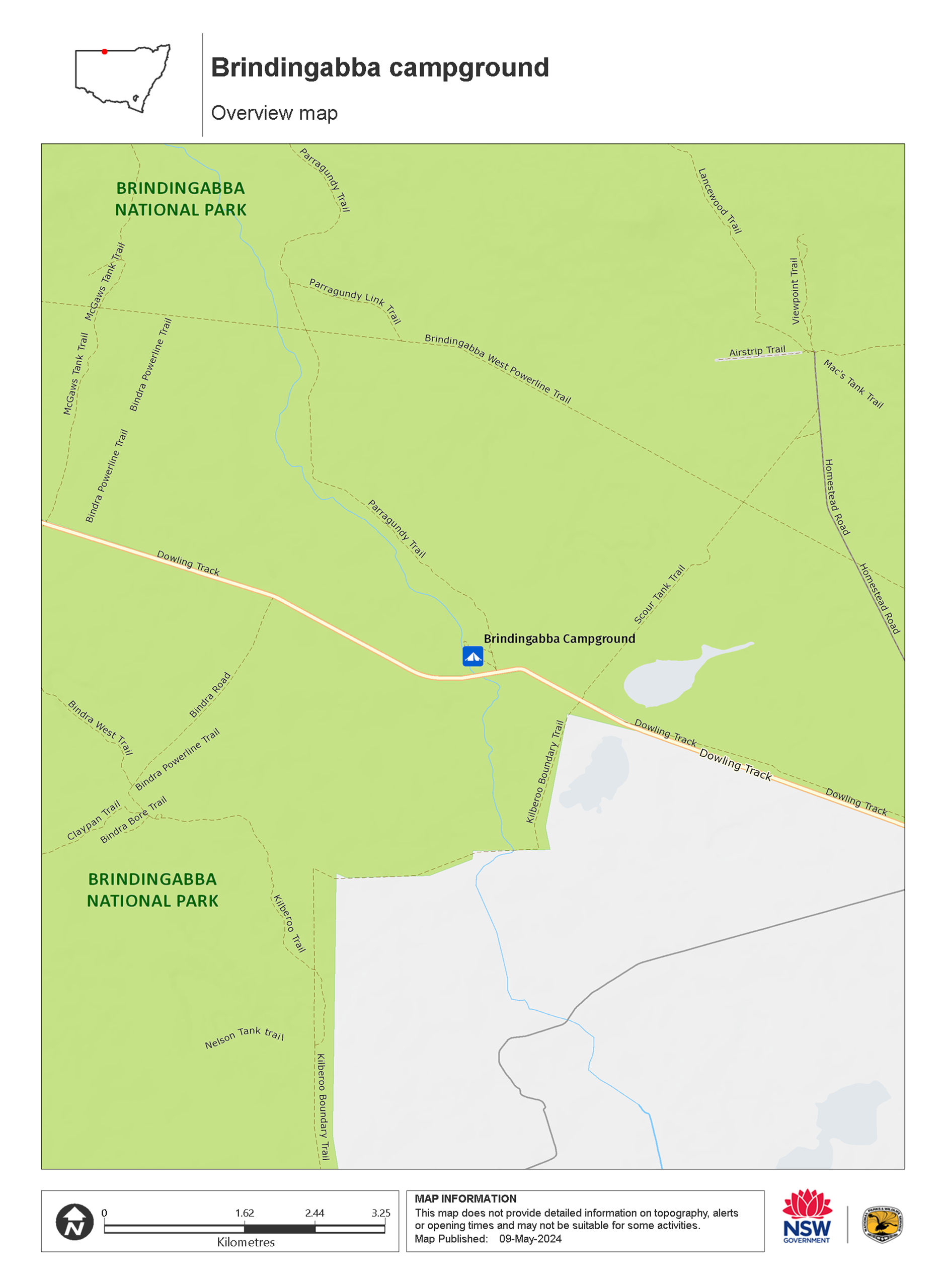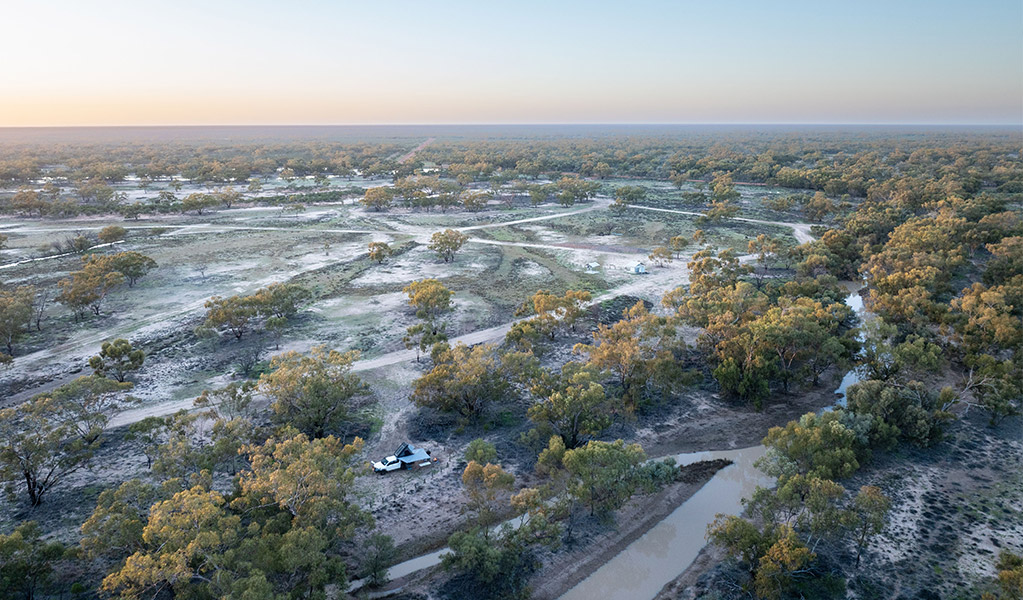Overview
On your outback tour of far north-west NSW, camp under the stars at Brindingabba campground, between Bourke and Hungerford.
| Number of campsites | 6 |
|---|---|
| Camping type | Camper trailer site, Caravan site, Tent, Camping beside my vehicle |
| Facilities | Toilets, unpowered sites, marked sites, barbecue facilities, picnic tables, carpark |
| What to bring | Insect repellent, satellite phone, sunscreen, cooking water, drinking water, firewood, fuel stove, ice, food supplies, torch, toilet paper |
| Price |
There are no camping fees at this campground but a $6 booking fee applies. |
| Bookings | Bookings for up to 2 sites and 12 people can be made online. |
| Group bookings | This campground is not suitable for group bookings. |
| Please note |
|
This quiet little campground is a welcome stop for adventurous campers travelling the Dowling Track outback route from Bourke to Birdsville.
Pitch your tent or caravan beside the coolabah trees that line Brindingabba Creek and admire the spectacular sunrises and sunsets of ‘corner country’ in Outback NSW. There’s plenty of room to spread out and each campsite has its own picnic table.
Although the creek is not always flowing the birds are always about. Pull up a chair by the creek bed for an early evening or morning bird watching session. Beginners may see bee-eaters and woodswallows darting about the creek bed, noisy mobs of pink cockatoos in the trees and visiting waterbirds. Experienced birders can hone their skills differentiating between babblers, treecreepers and other little brown (and not so brown) birds.
Get a taste of the park’s vast woodland plains, wetlands and flash of pink and yellow wildflowers on the scenic drive. Then loop back to the campground to settle in for the night beneath a blanket of evening stars.
Nearby
-

Brindingabba scenic drive
Brindingabba scenic drive is a must-do for intrepid 4WD travellers on their way from Bourke to Birdsville. It’s packed with wildlife so bring your binoculars and camera, and find out how many birds and animals you can see.
Map

Map legend

Local alerts
For the latest updates on fires, closures and other alerts in this area, see https://www.nationalparks.nsw.gov.au/camping-and-accommodation/campgrounds/brindingabba-campground/local-alerts
Bookings
- National Parks Contact Centre
- 7am to 7pm daily
- 1300 072 757 (13000 PARKS) for the cost of a local call within Australia excluding mobiles
- parks.info@environment.nsw.gov.au
Operated by
- Bourke office
- Monday to Friday, 8.30am to 4.30pm.
- 02 6830 0200
- npws.bourke@environment.nsw.gov.au
- 51-53 Oxley Street, Bourke NSW 2840
Park info
- in Brindingabba National Park in the Outback NSW region
Brindingabba National Park is always open but may have to close at times due to poor weather or fire danger.
Visitor info
All the practical information you need to know about Brindingabba campground.
Getting there and parking
Brindingabba campground is in Brindingabba National Park, located off the Dowling Track (Hungerford-Bourke Road), around 175km northwest of Bourke and 75km southeast of Hungerford. The campground is signposted and is about 800m off the Dowling Track.
Road quality
- Unsealed roads
Vehicle access
- Most roads require 4WD vehicle
Weather restrictions
- Dry weather only
Parking
Parking is available at the campground.
Facilities
- Water is not available at this campground so you'll need to bring your own supply for drinking and cooking.
- There are no bins so you’ll need to take all rubbish away with you.
Toilets
- Non-flush toilets
Types of sites
- Unpowered sites
- Marked sites
Barbecue facilities
- Fire rings (bring your own firewood)
Picnic tables
There is a picnic table with benches by each campsite.
Carpark
Maps and downloads
Accessibility
Disability access level - no wheelchair access
While the terrain is flat, all surfaces are unsealed and unmodified.
Permitted
Camp fires and solid fuel burners
Camping
Cycling
Fishing
A current NSW recreational fishing licence is required when fishing in all waters.
Prohibited
Recreational hunting in NSW National Parks is an illegal activity and a fineable offence.
Gathering firewood
Pets
Pets and domestic animals (other than certified assistance animals) are not permitted. Find out which regional parks allow dog walking and see the pets in parks policy for more information.
Smoking
NSW national parks are no smoking areas.
Learn more
Brindingabba campground is in Brindingabba National Park. Here are just some of the reasons why this park is special:
Protecting Aboriginal culture

Brindingabba National Park is in Budjiti and Kurnu Baakandji Country. Brindingabba is thought to mean 'thunder talks' in Kunja language. Aboriginal heritage items include stone hearths, wells and stone artefacts. We’re working with the local Aboriginal community to protect these important cultural sites.
The Brindingabba scenic drive skirts some sites. Please stay on the tracks to avoid disturbing them.
Home to amazing animals and plants

At least 12 endangered and 31 vulnerable species such as the kultarr, pink cockatoo and brolga are protected at Brindingabba National Park. You can find 96 sorts of birds here including the rare grey-crowned babbler.
The park also conserves mulga shrubland, blackbox and coolibah woodland, and grasslands. It’s the only NSW national park where you can see the endangered lancewood. Yapunyah, a gum tree which produces a delicious honey, also grows here. This tree is found only in outback northern NSW and southern Qld.
- Brindingabba scenic drive Brindingabba scenic drive is a must-do for intrepid 4WD travellers on their way from Bourke to Birdsville. It’s packed with wildlife so bring your binoculars and camera, and find out how many birds and animals you can see.
Preserving historic heritage

Brindingabba homestead was built in 1893 at the height of the wool boom. It’s a pisé or rammed earth structure. Its materials were harvested from the property’s red soils which can be seen on walls that have not been white-washed. Its wide verandas, tall ceilings and thick walls keep it cool in summer and warm in winter.
The homestead contains historical memorabilia collected by previous owners. Contact the Bourke office to find out when it’s open to visitors.
Nationally important wetlands

Brindingabba National Park lies in the Cuttaburra Basin, connecting 2 major outback rivers, the Paroo and the Warrego. The park protects more than 7,000 hectares of Yantabulla Swamp and part of Lake Wombah, which are nationally important wetlands. The wetlands provide habitat and breeding grounds for internationally protected migratory waterbirds such as freckled ducks, pink-eared ducks, brolgas and night herons.
Plants and animals protected in this park
Animals
-

Emu (Dromaius novaehollandiae)
The largest of Australian birds, the emu stands up to 2m high and is the second largest bird in the world, after the ostrich. Emus live in pairs or family groups. The male emu incubates and rears the young, which will stay with the adult emus for up to 2 years.
-

Red kangaroo (Macropus rufus)
The red kangaroo is one of the most iconic Australian animals and the largest marsupial in the world. Large males have reddish fur and can reach a height of 2m, while females are considerably smaller and have blue-grey fur. Red kangaroos are herbivores and mainly eat grass.
-

Short-beaked echidna (Tachyglossus aculeatus)
One of only 2 egg-laying mammals in the world, the short-beaked echidna is one of the most widespread of Australian native animals. Covered in spines, or quills, they’re equipped with a keen sense of smell and a tube-like snout which they use to break apart termite mounds in search of ants.
-

Wedge-tailed eagle (Aquila audax)
With a wingspan of up to 2.5m, the wedge-tailed eagle is Australia’s largest bird of prey. These Australian animals are found in woodlands across NSW, and have the ability to soar to heights of over 2km. If you’re bird watching, look out for the distinctive diamond-shaped tail of the eagle.
-

Tawny frogmouth (Podargus strigoides)
Found throughout Australia, the tawny frogmouth is often mistaken for an owl due to its wide, powerful beak, large head and nocturnal hunting habits. The ‘oom oom oom’ call of this native bird can be heard echoing throughout a range of habitats including heath, woodlands and urban areas.
Plants
-

Mulga (Acacia aneura)
Mulga are hardy Australian native plants found throughout inland Australia. With an unusually long tap root, the mulga is able to withstand long periods of drought.
-

River red gum (Eucalpytus camaldulensis)
Australian native plants, majestic river red gum trees are widespread across Australian inland river systems. The river red gum is a dominant tree species of the Murray-Darling basin which spans NSW, Queensland and Victoria. This iconic native eucalypt grows to a height of 30m and is thought to have a lifespan up to 500-1000 years.

